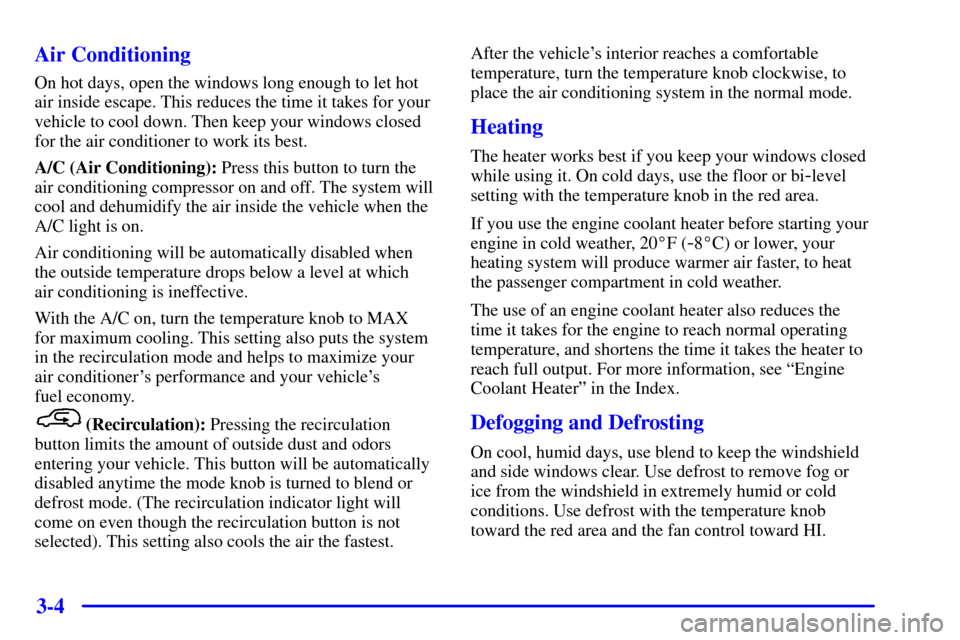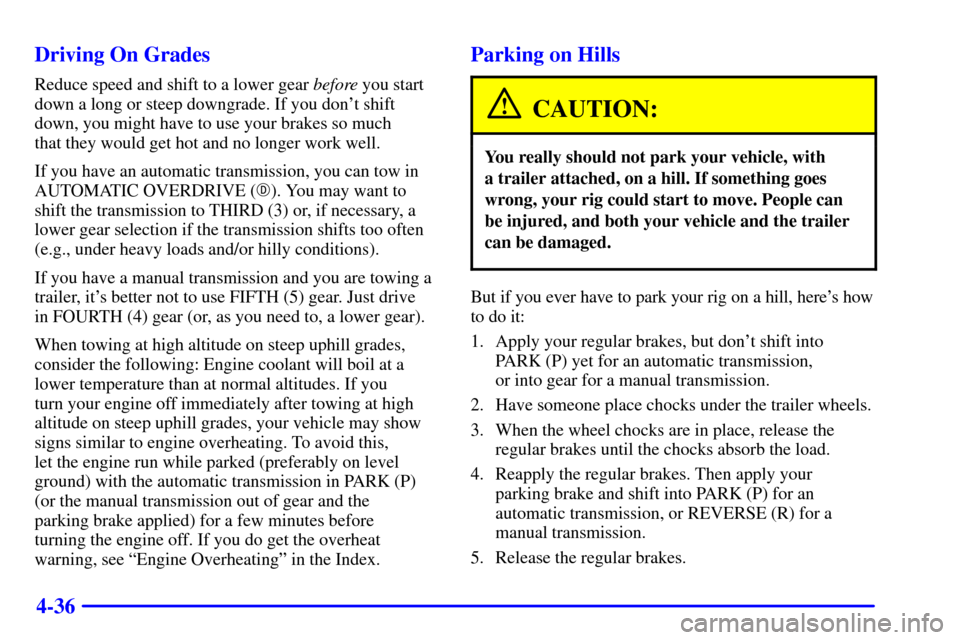Page 44 of 331

2-
2-1
Section 2 Features and Controls
Here you can learn about the many standard and optional features on your vehicle, and information on starting,
shifting and braking. Also explained are the instrument panel and the warning systems that tell you if everything is
working properly
-- and what to do if you have a problem.
2
-2 Windows
2
-4 Keys
2
-6 Door Locks
2
-7 Keyless Entry System (If Equipped)
2
-10 Theft
2
-11 Passlock�
2-12 New Vehicle ªBreak-Inº
2
-12 Ignition Positions
2
-14 Starting Your Gasoline Engine
2
-16 Engine Coolant Heater (If Equipped)
2
-17 Automatic Transmission Operation
2
-21 Manual Transmission Operation
2
-23 Parking Brake
2
-24 Shifting Into PARK (P)
(Automatic Transmission Only)
2
-27 Shifting Out of PARK (P)
(Automatic Transmission Only)2
-27 Parking Your Vehicle
(Manual Transmission Models Only)
2
-28 Parking Over Things That Burn
2
-28 Engine Exhaust
2
-29 Running Your Engine While You're Parked
(Automatic Transmission)
2
-30 Tilt Wheel (If Equipped)
2
-30 Turn Signal/Multifunction Lever
2
-37 Exterior Lamps
2
-39 Interior Lamps
2
-41 Mirrors
2
-44 Storage Compartments
2
-48 Instrument Panel - Your Information System
2
-50 Instrument Panel Cluster
2
-52 Warning Lights, Gages and Indicators
Page 59 of 331

2-16
Engine Coolant Heater (If Equipped)
In very cold weather, 0�F
(
-18�C) or colder, the
engine coolant heater can
help. You'll get easier
starting and better fuel
economy during engine
warm
-up. Usually, the
coolant heater should be
plugged in a minimum
of four hours prior to
starting your vehicle. At
temperatures above 32�F
(0�C), use of the coolant
heater is not required.
To Use the Engine Coolant Heater
1. Turn off the engine.
2. Open the hood and unwrap the electrical cord.
The engine coolant heater electrical cord is located
on the driver's side of the engine compartment, near
the power steering reservoir.
3. Plug it into a normal, grounded 110
-volt AC outlet.
CAUTION:
Plugging the cord into an ungrounded outlet
could cause an electrical shock. Also, the wrong
kind of extension cord could overheat and cause
a fire. You could be seriously injured. Plug the
cord into a properly grounded three
-prong
11 0
-volt AC outlet. If the cord won't reach, use a
heavy
-duty three-prong extension cord rated for
at least 15 amps.
4. Before starting the engine, be sure to unplug and
store the cord as it was before to keep it away
from moving engine parts. If you don't, it could
be damaged.
Page 60 of 331

2-17
How long should you keep the coolant heater plugged
in? The answer depends on the outside temperature, the
kind of oil you have, and some other things. Instead of
trying to list everything here, we ask that you contact
your dealer in the area where you'll be parking your
vehicle. The dealer can give you the best advice for that
particular area.Automatic Transmission Operation
There are several different positions for your shift lever.
If your vehicle is equipped with an automatic
transmission, it features an electronic shift position
indicator within the instrument panel cluster. This
display must be powered any time the shift lever is
capable of being moved out of PARK (P). This means
that if your key is in OFF, rather than LOCK, there will
be a small current drain on your battery which could
discharge your battery over a period of time. If you have
to leave your key in the ignition in OFF for an extended
period, it is recommended that you disconnect the
battery cable from the battery to prevent discharging
your battery.
Page 99 of 331
2-56 Engine Coolant Temperature Gage
This gage shows the engine
coolant temperature.
It also provides an indicator of how hard your vehicle is
working. During a majority of the operation, the gage
will read 210�F (100�C) or less. If you are pulling a
load or going up hills, it is normal for the temperature to
fluctuate and approach the 260�F (125�C) mark. If the
gage reaches the 260�F (125�C) mark, it indicates that
the cooling system is working beyond its capacity.
See ªEngine Overheatingº in the Index.
Malfunction Indicator Lamp (Service
Engine Soon Light in the United States
or Check Engine Light in Canada)
(Gasoline Engine)
United States Canada
Your vehicle is equipped with a computer which
monitors operation of the fuel, ignition and emission
control systems.
Page 103 of 331
2-60 Reduced Engine Power
The REDUCED ENGINE
POWER light will come
on when the cooling system
temperature gets too hot
and the engine further
enters the engine coolant
protection mode.
See ªEngine Overheatingº in the Index for
further information.
Oil Pressure Gage
United States Canada
The oil pressure gage shows the engine oil pressure in
psi (pounds per square inch) when the engine is running.
Canadian vehicles indicate pressure in kPa (kilopascals).
Page 105 of 331
2-62 Up Shift Light (If Equipped)
This light is used on models
with manual transmissions.
The SHIFT indicator light will help you get the best fuel
economy. See ªShift Lightº or ªShift Speedsº in this
section for more information.
Daytime Running Lamps Indicator Light
This light goes on whenever
the DRL are on.
When it begins to get dark, the DRL indicator light
comes on as a reminder to turn on your headlamps.
Check Gages Light
This light will come on
briefly when you are
starting the engine.
If the light comes on and stays on while you are driving,
it could indicate a problem with your vehicle. It could be
a problem with your oil pressure, coolant temperature,
or some other problem. Check your various gages to see
if they are in the warning zones. If they are, have your
vehicle serviced right away.
Page 110 of 331

3-4 Air Conditioning
On hot days, open the windows long enough to let hot
air inside escape. This reduces the time it takes for your
vehicle to cool down. Then keep your windows closed
for the air conditioner to work its best.
A/C (Air Conditioning): Press this button to turn the
air conditioning compressor on and off. The system will
cool and dehumidify the air inside the vehicle when the
A/C light is on.
Air conditioning will be automatically disabled when
the outside temperature drops below a level at which
air conditioning is ineffective.
With the A/C on, turn the temperature knob to MAX
for maximum cooling. This setting also puts the system
in the recirculation mode and helps to maximize your
air conditioner's performance and your vehicle's
fuel economy.
(Recirculation): Pressing the recirculation
button limits the amount of outside dust and odors
entering your vehicle. This button will be automatically
disabled anytime the mode knob is turned to blend or
defrost mode. (The recirculation indicator light will
come on even though the recirculation button is not
selected). This setting also cools the air the fastest.After the vehicle's interior reaches a comfortable
temperature, turn the temperature knob clockwise, to
place the air conditioning system in the normal mode.
Heating
The heater works best if you keep your windows closed
while using it. On cold days, use the floor or bi
-level
setting with the temperature knob in the red area.
If you use the engine coolant heater before starting your
engine in cold weather, 20�F (
-8�C) or lower, your
heating system will produce warmer air faster, to heat
the passenger compartment in cold weather.
The use of an engine coolant heater also reduces the
time it takes for the engine to reach normal operating
temperature, and shortens the time it takes the heater to
reach full output. For more information, see ªEngine
Coolant Heaterº in the Index.
Defogging and Defrosting
On cool, humid days, use blend to keep the windshield
and side windows clear. Use defrost to remove fog or
ice from the windshield in extremely humid or cold
conditions. Use defrost with the temperature knob
toward the red area and the fan control toward HI.
Page 168 of 331

4-36 Driving On Grades
Reduce speed and shift to a lower gear before you start
down a long or steep downgrade. If you don't shift
down, you might have to use your brakes so much
that they would get hot and no longer work well.
If you have an automatic transmission, you can tow in
AUTOMATIC OVERDRIVE (�). You may want to
shift the transmission to THIRD (3) or, if necessary, a
lower gear selection if the transmission shifts too often
(e.g., under heavy loads and/or hilly conditions).
If you have a manual transmission and you are towing a
trailer, it's better not to use FIFTH (5) gear. Just drive
in FOURTH (4) gear (or, as you need to, a lower gear).
When towing at high altitude on steep uphill grades,
consider the following: Engine coolant will boil at a
lower temperature than at normal altitudes. If you
turn your engine off immediately after towing at high
altitude on steep uphill grades, your vehicle may show
signs similar to engine overheating. To avoid this,
let the engine run while parked (preferably on level
ground) with the automatic transmission in PARK (P)
(or the manual transmission out of gear and the
parking brake applied) for a few minutes before
turning the engine off. If you do get the overheat
warning, see ªEngine Overheatingº in the Index.
Parking on Hills
CAUTION:
You really should not park your vehicle, with
a trailer attached, on a hill. If something goes
wrong, your rig could start to move. People can
be injured, and both your vehicle and the trailer
can be damaged.
But if you ever have to park your rig on a hill, here's how
to do it:
1. Apply your regular brakes, but don't shift into
PARK (P) yet for an automatic transmission,
or into gear for a manual transmission.
2. Have someone place chocks under the trailer wheels.
3. When the wheel chocks are in place, release the
regular brakes until the chocks absorb the load.
4. Reapply the regular brakes. Then apply your
parking brake and shift into PARK (P) for an
automatic transmission, or REVERSE (R) for a
manual transmission.
5. Release the regular brakes.